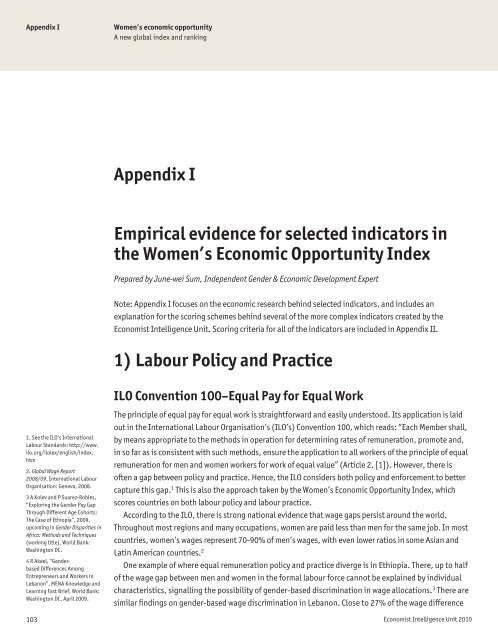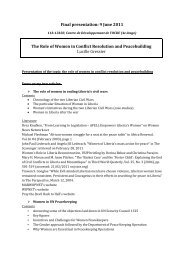Appendix IWomen’s economic opportunityA new global index and rankingAppendix IEmpirical evidence for selected indicators inthe Women’s <strong>Economic</strong> <strong>Opportunity</strong> <strong>Index</strong>Prepared by June-wei Sum, Independent Gender & <strong>Economic</strong> Development ExpertNote: Appendix I focuses on the economic research behind selected indicators, and includes anexplanation for the scoring schemes behind several of the more complex indicators created by the<strong>Economist</strong> <strong>Intelligence</strong> <strong>Unit</strong>. Scoring criteria for all of the indicators are included in Appendix II.1) Labour Policy and Practice1. See the ILO’s InternationalLabour Standards: http://www.ilo.org/ilolex/english/index.htm2. Global Wage Report2008/09, International LabourOrganisation: Geneva, 2008.3 A Kolev and P Suarez-Robles,“Exploring the Gender Pay GapThrough Different Age Cohorts:The Case of Ethiopia”, 2009,upcoming in Gender Disparities inAfrica: Methods and Techniques(working title), World Bank:Washington DC.4 R Akeel, “GenderbasedDifferences AmongEntrepreneurs and Workers inLebanon”, MENA Knowledge andLearning Fast Brief, World Bank:Washington DC, April 2009.ILO Convention 100–Equal Pay for Equal WorkThe principle of equal pay for equal work is straightforward and easily understood. Its application is laidout in the International Labour Organisation’s (ILO’s) Convention 100, which reads: “Each Member shall,by means appropriate to the methods in operation for determining rates of remuneration, promote and,in so far as is consistent with such methods, ensure the application to all workers of the principle of equalremuneration for men and women workers for work of equal value” (Article 2, [1]). However, there isoften a gap between policy and practice. Hence, the ILO considers both policy and enforcement to bettercapture this gap. 1 This is also the approach taken by the Women’s <strong>Economic</strong> <strong>Opportunity</strong> <strong>Index</strong>, whichscores countries on both labour policy and labour practice.According to the ILO, there is strong national evidence that wage gaps persist around the world.Throughout most regions and many occupations, women are paid less than men for the same job. In mostcountries, women’s wages represent 70-90% of men’s wages, with even lower ratios in some Asian andLatin American countries. 2One example of where equal remuneration policy and practice diverge is in Ethiopia. There, up to halfof the wage gap between men and women in the formal labour force cannot be explained by individualcharacteristics, signalling the possibility of gender-based discrimination in wage allocations. 3 There aresimilar findings on gender-based wage discrimination in Lebanon. Close to 27% of the wage difference103 <strong>Economist</strong> <strong>Intelligence</strong> <strong>Unit</strong> 2010
Appendix IWomen’s economic opportunityA new global index and ranking5. Gender Brief, OECD SocialPolicy Division: Paris, March2010.6. See for example J Albrecht,A Bjorklund and S Vroman, “Isthere a Glass Ceiling in Sweden?”Journal of Labour <strong>Economic</strong>s, Vol.21, No. 1, University of Chicago,2003.W Arulampalam, A L Booth andM L Bryan, “Is there are glassceiling over Europe? Exploringthe Gender Wage Gap across theWage Distribution”, Industrialand Labour Relations Review, Vol.60, No. 2, January 2007, CornellUniversity: Ithaca NY.7. C Dolan, M Opondo andS Smith, “Gender, Rights &Participation in the Kenya CutFlower Industry”, NationalResources Institute Report No.2768, SSR Project No. R80772002-4, 20028. F D Blau and L M Kahn,“The Gender Earnings Gap:Learning from InternationalComparisons”, American<strong>Economic</strong> Review Papers andProceedings, Vol. 82, No. 2,1992, pages 533-38.— “Wage structure and genderearnings differentials: Aninternational comparison”,<strong>Economic</strong>a, Vol. 63, Issue 250,1996, Suppl. S29-62.9. F D Blau and L M Kahn,“Understanding InternationalDifferences in the GenderPay Gap”, Journal of Labour<strong>Economic</strong>s, Vol. 21, No. 1, 2003,pages 106-144.10. International LabourOrganisation EmploymentTrends, “Women in labourmarkets: Measuring progressand identifying challenges”,978-92-2-123319-0 (web print)(ISBN), International LabourOrganisation: Geneva, 2010.between male and female employees was shown by statistical analysis to be plausibly attributableto discrimination. Wage gaps exist within the same sector and occupation even after controlling fordifferent levels of education. However, wage discrimination varies by age and is non-existent foryounger female workers. 4Even across OECD countries, median earnings for men are on average about 18% higher than for women.The largest differences are in Japan and South Korea, where the gap is more than 30%. The OECD citesgender discrimination as one of the factors behind this gap. Separately, women are more likely to be in lowpaidoccupations, with fewer chances for promotion. Childcare responsibilities mean women are also morelikely to work part-time. 5 (The <strong>Index</strong> addresses the issue of access to childcare in a separate indicator).Further ReadingInternational Labour Organisation Employment Trends, “Women in labour markets: Measuring progressand identifying challenges”, 978-92-2-123319-0 (web print) (ISBN). ILO: Geneva, 2010ILO Convention 111–Non-discrimination in EmploymentThe elimination of discrimination in employment or occupation, based on race, colour, sex, religion,political opinion, national extraction or social origin, is the basis of ILO Convention 111. Scoring of the<strong>Index</strong>’s indicator is based on the ILO’s monitoring efforts of this Convention, and covers both policy andpractice.In many countries, women are clustered in lower-paying jobs, whether lower-skilled work or part-timework chosen by women to balance household responsibilities. Even in countries in which women havebeen able to enter professional fields, there remains the well-documented “glass ceiling” phenomenon(the inability to rise within an organisation beyond a certain responsibility level, irrespective of individualperformance or credentials). 6 Employers often hold gendered notions of what these jobs are worth, andthis bias often leads to lower pay for women. For example, in Ethiopia and Kenya, women looking forjobs in cut-flower processing plants are mostly hired for lower-paid post-harvest seasonal handling offlowers, whereas men usually fill permanent, better-paying jobs that require workers to operate machinesor manage others in the plant. 7 Blau and Khan have demonstrated that the general wage inequality in acountry has a large effect on the gender wage gap, since women are typically on the lower end of the wagedistribution scale. Therefore, the higher the inequality of wages in a country, the larger the gender wagegap will typically be. 8 In further research in 2003, Blau and Khan find that a narrower male wage structureand lower female labour supply results in a smaller gender pay gap. Moreover, they find that collectivebargaining reduces the wage differential. 9Recent research shows gender disparity in terms of both opportunities and quality of employment forwomen versus men. 10 Encouragingly, supranational legal measures that are meant to address this—suchas ILO Convention 111—have been shown to have a positive effect in reducing the gap. Weichselbaumerand Rudolf (2007) constructed a dataset of published values of gender wage gaps in different countries,and made them comparable by the use of meta-regression analysis. These data were later supplementedwith information on the business environment and equal treatment laws, which allowed them toinvestigate the impacts of these two factors. Meta-analysis of the data shows that increased adoption of104 <strong>Economist</strong> <strong>Intelligence</strong> <strong>Unit</strong> 2010




